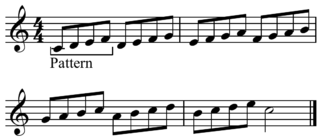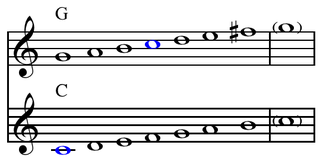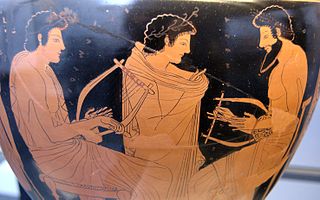In western music theory, a diatonic scale is a heptatonic scale that includes five whole steps and two half steps (semitones) in each octave, in which the two half steps are separated from each other by either two or three whole steps, depending on their position in the scale. This pattern ensures that, in a diatonic scale spanning more than one octave, all the half steps are maximally separated from each other.
In music, a tone row or note row, also series or set, is a non-repetitive ordering of a set of pitch-classes, typically of the twelve notes in musical set theory of the chromatic scale, though both larger and smaller sets are sometimes found.
In music theory, a scale is any set of musical notes ordered by fundamental frequency or pitch. A scale ordered by increasing pitch is an ascending scale, and a scale ordered by decreasing pitch is a descending scale. Some scales contain different pitches when ascending than when descending, for example, the melodic minor scale.

A transposing instrument is a musical instrument whose music is recorded in staff notation at a pitch different from the pitch that actually sounds. A written middle C on a transposing instrument produces a pitch other than middle C, and that pitch identifies the interval of transposition when describing the instrument. For example, a written C on a B♭ clarinet sounds a concert B♭.
An octatonic scale is any eight-note musical scale. However, the term most often refers to the symmetric scale composed of alternating whole and half steps, as shown at right. In classical theory, this scale is commonly simply called the octatonic scale although there are a total of 42 non-enharmonically equivalent, non-transpositionally equivalent eight-note sets.

In music, a ninth is a compound interval consisting of an octave plus a second.
Dorian mode or Doric mode can refer to three very different but interrelated subjects: one of the Ancient Greek harmoniai, one of the medieval musical modes, or, most commonly, one of the modern modal diatonic scales, corresponding to the white notes from D to D, or any transposition of this.
In music transposition refers to the process, or operation, of moving a collection of notes up or down in pitch by a constant interval.
The shifting of a melody, a harmonic progression or an entire musical piece to another key, while maintaining the same tone structure, i.e. the same succession of whole tones and semitones and remaining melodic intervals.
Makam is a system of melody types used in Arabic, Persian and Turkish classical music. It provides a complex set of rules for composing and performance. Each makam specifies a unique intervalic structure (cinsler) and melodic development (seyir).
Modes of limited transposition are musical modes or scales that fulfill specific criteria relating to their symmetry and the repetition of their interval groups. They were compiled by the French composer Olivier Messiaen, and published in his book La technique de mon langage musical.
The musical operation of scalar transposition shifts every note in a melody by the same number of scale steps. The musical operation of chromatic transposition shifts every note in a melody by the same distance in pitch class space. In general, for a given scale S, the scalar transpositions of a line L can be grouped into categories, or transpositional set classes, whose members are related by chromatic transposition. In diatonic set theory cardinality equals variety when, for any melodic line L in a particular scale S, the number of these classes is equal to the number of distinct pitch classes in the line L.
In diatonic set theory structure implies multiplicity is a quality of a collection or scale. This is that for the interval series formed by the shortest distance around a diatonic circle of fifths between members of a series indicates the number of unique interval patterns formed by diatonic transpositions of that series. Structure being the intervals in relation to the circle of fifths, multiplicity being the number of times each different (adjacent) interval pattern occurs. The property was first described by John Clough and Gerald Myerson in "Variety and Multiplicity in Diatonic Systems" (1985).

In music and jazz improvisation, a melodic pattern is a cell or germ serving as the basis for repetitive pattern. It is a figure that can be used with any scale. It is used primarily for solos because, when practiced enough, it can be extremely useful when improvising. "Sequence" refers to the repetition of a part at a higher or lower pitch, and melodic sequence is differentiated from harmonic sequence. One example of melodic motive and sequence are the pitches of the first line, "Send her victorious," repeated, a step lower, in the second line, "Happy and glorious," from "God Save the Queen".
In music, a sequence is the restatement of a motif or longer melodic passage at a higher or lower pitch in the same voice. It is one of the most common and simple methods of elaborating a melody in eighteenth and nineteenth century classical music. Characteristics of sequences:

Music theory has no axiomatic foundation in modern mathematics, yet the basis of musical sound can be described mathematically and exhibits "a remarkable array of number properties". Elements of music such as its form, rhythm and metre, the pitches of its notes and the tempo of its pulse can be related to the measurement of time and frequency, offering ready analogies in geometry.
In music, a symmetric scale is a music scale which equally divides the octave. The concept and term appears to have been introduced by Joseph Schillinger and further developed by Nicolas Slonimsky as part of his famous "Thesaurus of Scales and Melodic Patterns". In twelve-tone equal temperament, the octave can only be equally divided into two, three, four, six, or twelve parts, which consequently may be filled in by adding the same exact interval or sequence of intervals to each resulting note.
In music theory, the word inversion has distinct, but related, meanings when applied to intervals, chords, voices, and melodies. The concept of inversion also plays an important role in musical set theory.
Post-tonal music theory is the set of theories put forward to describe music written outside of, or 'after', the tonal system of the common practice period. It revolves around the idea of 'emancipating dissonance', that is, freeing the structure of music from the familiar harmonic patterns that are derived from natural overtones. As music becomes more complex, dissonance becomes indistinguishable from consonance.

In music, a common tone is a pitch class that is a member of, or common to two or more scales or sets.








